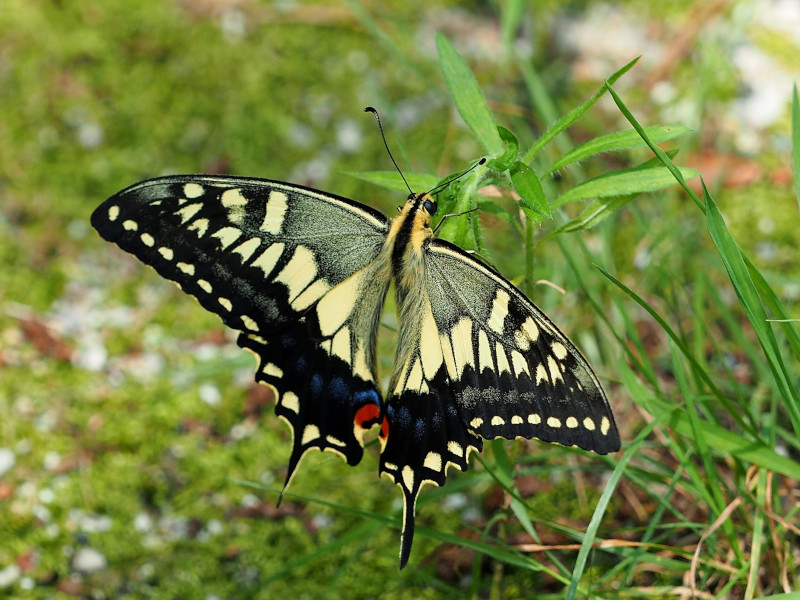
Old World Swallowtail Facts
- The most often employed common name for this gorgeous creation of Nature and evolution is the informative term of Old World Swallowtail. The stunning invertebrate does have other alternate titles, though. These include the similar epithet common yellow swallowtail.
- Within most scientific circles, however, the delicate creature’s likely much better known by its technical label. Thankfully, that’s a relatively simple term for the layperson to pronounce. That’s because the truly lovely Lepidoptera holds the official moniker of Papilio machaon.
- The Arthropod received that scientific designation due to the efforts of Carl Linnaeus himself. The eminent Swedish zoologist accomplished the first recognition of the animal as a separate and distinct species. That scientifically noteworthy deed occurred in the year 1758.
- It’s fully notable for far more than just its great beauty, though. That’s due to an particularly impressive statistic the insect holds. That’s true since, to date, entomologists recognize an extraordinary total of 41 separate subspecies of this intriguing butterfly still in existence.
- Fortunately, the amazing Old World Swallowtail appears to be maintaining a population base that’s both sufficient and stable. This pleasant state of affairs further seems to hold true across the entirety of its range. The IUCN therefore currently lists it as Least Concern on its Red List.
- The magnificent insect nonetheless must be considered as facing the same potential threats to its existence as all other species, at least. Most of these perils stem from the actions of mankind. They include such varied dangers as habitat loss and ongoing climate change.
Related Articles
Old World Swallowtail Physical Description
The truly breathtaking Old World Swallowtail typically captivates those individuals fortunate enough to encounter the marvel. Pure physical size isn’t generally one of those, though. That’s because, regardless of its eye-catching appeal, it’s a roughly average-sized member of its Order.
It distingishes itself in this regard in one very specific manner, however. That’s true given that fact that, unlike most of its kindred, it displays no noticeable degree of the physiological characteristic of sexual dimorphism. This makes identifying the genders difficult for many of its observers.
The body of the caterpillar stage of both sexes of the wonder attains an average length equaling approximately 1.8 in (4.6 cm). That of the mature adult retains roughly the same measurement. Though mostly showing black above, with yellow trim, the underside mainly presents as yellow.
It’s the captivating wings of the visually stunning Old World Swallowtail that generally garner the most attention, however. These appendages often vary significantly in wingspan, regardless of gender. On average, this equals between 2.6 – 3.4 in (6.5 – 8.6 cm). Few exceed this by much.
On the upperside of both hindwings, a distinctive feature usually appears. That’s the existence of a relatively large eyespot located near the tail of the remarkable invertebrate. This itself shows a reddish-orange shade, with the presence of a black border near the edge of the hindwing.
Further enhancing this is the presence of 6 small, blue eye-spots located on the same wing. Yet Nature isn’t done with this wonder of evolution yet. These same hindwings also possess a pair of sharply protruding tail-like structures. These provide a resemblance to the bird of the same name.
- Kingdom: Animalia
- Phylum: Arthropoda
- Class: Insecta
- Order: Lepidoptera
- Family: Papilionidae
- Genus: Papilio
- Species: P. machaon
Old World Swallowtail Distribution, Habitat, and Ecology
The intensely beautiful Old World Swallowtail apparently evolved as native to an extremely wide expanse of the surface of the earth. The precise location of that zone of habitation, though, probably won’t surprise many people, though. It’s clearly intimated by the very name of the Arthropod.
The mesmerizing insect developed as partly endemic to what’s known as the Old World region of the earth. Yet the invertebrate also evolved as native to an even greater range. That includes the entirety of both Europe and Asia, and even extends to portions of the northern sections of Africa.
The intrepid animal also demonstrates a decidedly flexible approach to its preferences regarding its choice of habitat. The butterfly therefore inhabits a moderately broad range of ecosystems. These typically consist of such regions as areas of meadows, hilltops, and even areas of tundra.
It further displays an amazing adaptability to an extensive range of altitudes across its native range. In some regions, the invertebrate lives near sea level. In other sections, though, like the Kashmir Valley, individuals sometimes appear at heights of up to as great as 16,000 ft (4,877 m).
Like its countless living relatives, the Old World Swallowtail developed as entirely herbivorous in nature. Adults of this particular species primarily feed on the flower nectar of plants from a single Family. In its case, this consists of members of what’s commonly known as the celery Family.
After concluding the mating process, females lay eggs individually, usually on the underside of a food plant. The caterpillar form feeds on a wider variety of sources than the adults. The males of the beautiful butterfly frequently congregates in numbers to compete for approaching females.
Species Sharing Its Range
Check out our other articles on 5 Beautiful Black Sea Species, Wisent, Waw an Namus, Oceanic whitetip shark, Rosy Veincap, Guinan cock-of-the-rock, Blue Orchard Bee, Aldabra Giant Tortoise
